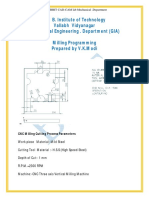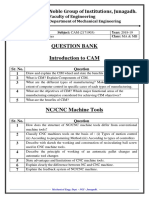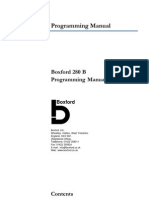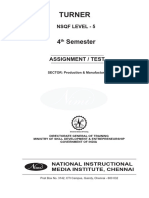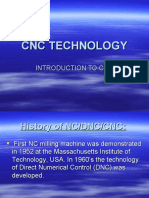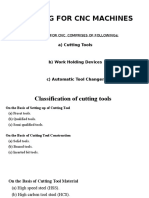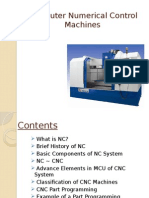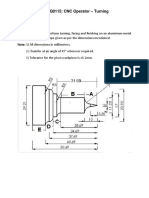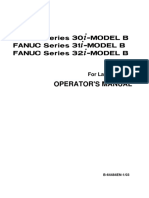CAM
CAM
Uploaded by
Jay JoshiCopyright:
Available Formats
CAM
CAM
Uploaded by
Jay JoshiOriginal Title
Copyright
Available Formats
Share this document
Did you find this document useful?
Is this content inappropriate?
Copyright:
Available Formats
CAM
CAM
Uploaded by
Jay JoshiCopyright:
Available Formats
Computer aided manufacturing
3361901
GUJARAT TECHNOLOGICAL UNIVERSITY, AHMEDABAD, GUJARAT
COURSE CURRICULUM
COURSE TITLE: COMPUTER AIDED MANUFACTURING (CAM)
(COURSE CODE:3361901)
Diploma Programme in which this course is offered
MECHANICAL ENGINEERING
Semester in which offered
SIXTH
1. RATIONALE.
The era of conventional machines are being limited. Evolution of information
technology, variety manufacturing concepts with zero lead time demand and
quality consciousness have supported fast adaption of computerized numerical
control (CNC) machines. CNC programming has more importance along with
selection and use of CNC tooling. An attempt has been made to focus exclusively
on CNC machines and advance development. CNC machines normally are not
only limited to machine tools but in real its use has widened in almost all areas of
manufacturing, processes and support activities.
2. COMPETENCY.
The course content should be taught and implemented with the aim to develop
different types of skills so that students are able: to acquire following
competencies.
Select required operating parameters, appropriate tools, tool holders,
accessories and consumables for manufacturing a given job on CNC.
Manufacture simple jobs using CNC part program
3. COURSE OUTCOMES.
Students will be able to
i.
ii.
iii.
iv.
Identify different axes, machine zero, home position, controls and
features of CNC machines.
Select, mount and set cutting tools and tool holders on CNC.
Prepare part programmes using ISO format for given simple components
with and without use of MACRO, CANNED CYCLE and
SUBROUTINE using ISO format.
Interface software application for auto part programming.
4. TEACHING AND EXAMINATION SCHEME.
Total
Examination Scheme
Teaching Scheme
Credits
Practical
(In Hours)
(L+T+P Theory Marks
Marks
)
L
ESE
PA
ESE
PA
70
30
20
30
Total
Marks
150
GTU/ NITTTR Bhopal/14-1
Gujarat State
1
Computer aided manufacturing
3361901
Legends: L-Lecture; T Tutorial/Teacher Guided Theory Practice; P -Practical; C
Credit, ESE -End Semester Examination; PA - Progressive Assessment.
5. COURSE DETAILS.
Unit
Unit I.
Fundamentals
of CAM.
Unit- II
Constructional
features
of
CNC
machines.
Major Learning
Outcomes
(in cognitive
domain)
1a. Differentiate
between
NC,
CNC and DNC.
1b. Identify
parameters
governing
for
selection of CNC
machines.
2a. Classify
CNC
machines.
2b. Identify role of
main elements of
CNC machines.
2c. Identify
CNC
axes.
2d. Preset tool on
CNC machines.
2e. Use
qualified
tools and tool
holders on CNC
machines.
Topics and Sub-topics
1.1
1.2
1.3
1.4
2.1
2.2
2.3
2.4
2.5
2.6
3.1
Unit III
CNC
machines.
3a. List features of
specified CNC
turning
centre
and
CNC
machining
centre.
3b. Identify various
work holding and
tool
holding
devices.
GTU/ NITTTR Bhopal/14-1
3.2
CAM - concept and definition.
NC
(Numerical
Control),
CNC
(Computerized Numerical Control) and
DNC (Direct Numerical Control) concept, features and differences.
Advantages and limitations of CNC.
Selection criteria for CNC machines.
CNC machines: Types, classification,
working and constructional features.
Spindle drives and axes drives on CNC
machines.
Machine structure- Requirements and
reasons.
Elements of CNC machines - Types,
sketch, working and importance of:
i. Slide ways.
ii. Re-circulating ball screw.
iii. Feedback devices (transducers,
encoders).
iv. Automatic tool changer (ATC).
v. Automatic pallet changer (APC).
CNC axes and motion nomenclature.
CNC tooling :
i. Tool presetting-concept and
importance.
ii. Qualified tools-definition need
and advantages.
iii. Tool
holderstypes
and
applications.
CNC turning centres:
i. Types.
ii. Features.
iii. Axes nomenclature.
iv. Specification.
v. Work holding devices -types,
working and applications.
vi. Tool holding and changing
devices - types, working and
applications.
CNC machining centres:
Gujarat State
2
Computer aided manufacturing
Unit
3361901
Major Learning
Outcomes
(in cognitive
domain)
3c. Select
suitable
CAD/CAM
interfacing
standard.
Topics and Sub-topics
i.
ii.
iii.
iv.
v.
3.3
Unit IV
CNC part
programming.
4a. Interpret and use
ISO format of
CNC
part
programming.
4b. Use important G
and M codes in
CNC
part
programming.
4c. Set
various
compensations
on CNC.
4d. Prepare simple
part programme.
4e. Prepare
a job
using advanced
CNC
part
programming
features
like
canned cycle, do
loop, subroutine
etc.,
4.1
4.2
4.3
4.4
4.5
4.6
4.7
4.8
4.9
GTU/ NITTTR Bhopal/14-1
B Types.
Features.
Axes nomenclature.
Specification.
Work holding devices-types,
working and applications.
vi. Tool holding and changing
devices- types, working and
applications.
Types and applications of CAD/CAM
interfacing standards.
Definition and importance of various
positions like machine zero, home
position, work piece zero and
programme zero.
CNC part programming: programming
format and structure of part programme.
ISO G and M codes for turning and
milling-meaning and applications of
important codes.
Model and non-model G and M codes.
Need and importance of various
compensations:
i. Tool length compensation.
ii. Pitch error compensation.
iii. Tool radius compensation.
iv. Tool offset.
Simple part programming for turning
using ISO format having straight
turning,
taper
turning
(linear
interpolation)
and
convex/concave
turning (circular interpolation).
Simple part programming for milling
using ISO format.
Importance, types, applications and
format for:
i. Canned cycles.
ii. Macro.
iii. Do loops.
iv. Subroutine.
CNC turning and milling part
programming using canned cycles, Do
loops and Subroutine.
Gujarat State
3
Computer aided manufacturing
3361901
Unit
Unit V
Recent trends
in CAM.
Major Learning
Outcomes
(in cognitive
domain)
5a. List source of
variability
for
adaptive control.
5b. Interpret
different
FMS
layouts.
5c. Correlate areas
of CIM.
5d. Identify
types
and elements of
robots.
5e. Describe concept
of
Rapid
prototyping.
6. SUGGESTED
SPECIFICATION
TABLE
Topics and Sub-topics
5.1
5.2
5.3
5.4
5.5
Adaptive control- definition, meaning,
block diagram, sources of variability and
applications.
Flexible Manufacturing System (FMS) concept, evaluation, main elements and
their functions, layout and its
importance, applications.
Computer Integrated Manufacturing
(CIM) - Concept, definition, areas
covered, benefits.
Roboticsdefinition,
terminology,
classification and types, elements and
applications.
Rapid prototyping - Concept and
application
WITH
HOURS
AND
MARKS
(THEORY).
Unit
No.
Teaching
Hours
Unit Title
Distribution of Theory Marks
R
U
A
Total
Level Level Level Marks
Fundamentals of Computer Aided
4
4
6
0
Manufacturing
II
Constructional Features of CNC
5
6
4
4
machines
III
CNC machines.
4
2
5
2
IV
CNC part programming.
10
4
7
14
V
Recent trends in CAM.
5
4
8
0
Total
28
20
30
20
Legends: R = Remember U= Understand; A= Apply and above levels (Blooms revised
taxonomy).
Note: This specification table shall be treated as a general guideline for students and
teachers. The actual distribution of marks in the question paper may vary slightly from
above table.
General Notes:
a. If mid-sem test is part of continuous evaluation, unit numbers I, II and III are to
be considered.
b. Ask the questions from each topic as per marks weight age. Numerical
questions are to be asked only if it is specified. Optional questions must be
asked from the same topic.
GTU/ NITTTR Bhopal/14-1
Gujarat State
4
10
14
9
25
12
70
Computer aided manufacturing
7.
3361901
SUGGESTED LIST OF EXERCISES/PRACTICALS.
The practical/exercises should be properly designed and implemented with an attempt
to develop different types of skills (outcomes in psychomotor and affective domain)
so that students are able to acquire the competencies/programme outcomes. Following
is the list of practical exercises for guidance.
Note: Here only outcomes in psychomotor domain are listed as practical/exercises.
However, if these practical/exercises are completed appropriately, they would also
lead to development of certain outcomes in affective domain which would in turn lead
to development of Course Outcomes related to affective domain. Thus over all
development of Programme Outcomes (as given in a common list at the beginning of
curriculum document for this programme) would be assured.
Faculty should refer to that common list and should ensure that students also acquire
outcomes in affective domain which are required for overall achievement of
Programme Outcomes/Course Outcomes.
Sr.
No.
Unit
No.
II
IV
IV
Practical Exercises
(outcomes in Psychomotor Domain)
Approx.
Hours.
required
Demonstration of constructional features of CNC:
a. Demonstrate CNC machines and operations.
b. List major parts of CNC.
c. Write specification of CNC taken for demonstration.
d. Sketch important tool holders.
e. Tabulate sensors / feedback devices with type,
specification and purposes used on CNC taken for
demonstration.
f. Sketch display console. Also sketch symbols used on
display console with meaning of each.
g. State interfacing standards used.
CNC turning part programming:
Teacher will assign part drawings. Minimum five drawings
having following details are to be assigned. This include
parts- (i) Simple turning with steps, (ii) Turning with tapers,
(iii) Turning with circular (concave / convex shape)
interpolation, (iv) Turning using canned cycle - with
threading or drilling or other and (v)Turning with use of
subroutine or macro or do-loop.
a. Sketch each part with dimensions.
b. Prepare CNC part programme using G and M codes
with ISO format.
c. Show various zeros and tool path on part sketch with
color codes and dimensions.
d. Simulate the prepared part programmes using
available simulation softwares.
e. Prepare the parts on CNC.
CNC machining centre part programming:
Teacher will assign part drawings. Minimum three drawings
having following details are to be assigned. This include
parts- (i) Simple contour milling (ii) Contour milling with
GTU/ NITTTR Bhopal/14-1
Gujarat State
5
06
10
08
Computer aided manufacturing
III
ALL
3361901
(convex / concave) circular interpolation and (iii) contour
milling with drilling / tapping.
a. Sketch each part with dimensions.
b. Prepare CNC part programme using G and M codes
with ISO format.
c. Show various zeros and tool path on part sketch with
color codes and dimensions.
d. Simulate the prepared part programmes using
available simulation softwares.
e. Prepare the parts on CNC.
Demonstration of CAD/CAM integration:
a. Demonstrate CAD / CAM integration.
b. List interfacing standards.
Industrial visit:
Visit nearby industry having CNC machines. List and state
important features of them with detail specifications and
name of manufacturers.
Total Hours
02
02
28
Notes:
a. It is compulsory to prepare log book of exercises. It is also required to get each
exercise recorded in logbook, checked and duly dated signed by teacher.PA
component of practical marks is dependent on continuous and timely
evaluation and submission of exercises.
b. Term work report must not include any photocopy / ies, printed manual/pages,
litho, etc. It must be hand written / hand drawn by student only.
c. Mini project and presentation topic/area has to be assigned to the group of
specified students in the beginning of the term by batch teacher, if applicable.
d. For practical ESE part, students are to be assessed for competencies achieved.
They should be given experience/part of experience to perform as under.
i. B
8. SUGGESTED LIST OF STUDENT ACTIVITIES.
SR.NO.
1
2
3
4
ACTIVITY
Visit nearby industry having CNC machines. List and state important features of
them.
Prepare specifications of various types of CNC machines with images and names
of manufacturers.
Download images and videos of CNC machines and its parts. Prepare one
VCD/DVD in a a batch and submit to batch teacher.
Download free simulation softwares available on website and practice for part
programming.
GTU/ NITTTR Bhopal/14-1
Gujarat State
6
Computer aided manufacturing
9.
3361901
SPECIAL INSTRUCTIONAL STRATEGIES (if any).
Sr.
No.
1
Unit
Unit Name
Strategies
Introduction.
Constructional Features
of CNC machines
CNC machines.
Videos, Presentations, Demonstration.
Videos,
Presentations,
Industrial
Visits,
Demonstration,
Videos,
Presentations,
Industrial
Visits,
Demonstration,
Simulation softwares, actual practice on CNC
machines, Demonstration,
Videos, Presentations, Industrial Visits,
II
III
IV
CNC part programming.
Recent trends in CAM.
10. SUGGESTED LEARNING RESOURCES.
A.
List of Books:
S.
No.
1.
Title of Book
Author
CNC Machines.
Computer Numerical ControlTurning and Machining centers.
CAD/CAM.
Introduction
to
NC/CNC
Machines.
2.
3.
4.
5.
Computer Aided Manufacturing.
6.
CAD/CAM: computer aided
design and manufacturing.
Publication
Pabla B.S., Adithan M.
New
Age
International, New
Delhi,2014(reprint).
Quesada Robert
Prentice Hall 2014.
Sareen Kuldeep
S.Chand 2012.
S.K.Kataria
&
Sons. 2012.
Tata McGraw Hill
2014.
Vishal S.
Rao P N, Tiwari N K,
Kundra T
Groover
Mikell
P,
Zimmered W Emory
Prentice Hall 2011.
B) List of Major Equipment/ Instruments with Broad Specifications:
Sr. No.
1
Resource with brief specification.
CNC Turning Centre (Tutor or Productive)Minimum diameter 25 mm, Length 120 mm with ATC. (Approximate)
CNC Machining Centre (Tutor or Productive)X axis travel - 225 mm, Y axis travel - 150 mm, Z axis travel - 115 mm, With ATC.
(Approximate)
Simulation software likes: CNC Simulator Pro, Swansoft CNC, etc.
Latest version of CAD/CAM integration software like MASTER CAM, NX CAM.
etc.
GTU/ NITTTR Bhopal/14-1
Gujarat State
7
Computer aided manufacturing
3361901
C. List of Software/Learning Websites.
i.
ii.
iii.
iv.
v.
vi.
vii.
11.
http://www.nptel.ac.in
http://www.youtube.com/watch?v=M3eX2PKM1RI
http://www.youtube.com/watch?v=EHQ4QIDqENI&list=PLBkq
kLQO2nAt5MNLoaeUhvkFS9M0p8y_1
http://www.youtube.com/watch?v=hJFLcvtiNQI
http://www.youtube.com/watch?v=BIM1AyxfYkw.
http://www.mtabindia.com
http://www.swansoftcncsimulator.com
COURSE CURRICULUM DEVELOPMENT COMMITTEE
Faculty Members from Polytechnics.
Prof K.P. Patel, H.O.D, Mechanical Department, B.S.Patel Polytechnic,
Kherva.
Prof J.B.Patel, Sr. Lecturer, Mechanical Department, R.C.Technical Institute,
Ahmedabad
Prof R.A, Prajapati, Sr. Lecturer, Mechanical Department, R.C.Technical
Institute, Ahmedabad
Coordinator and Faculty Members from NITTTR Bhopal.
Dr. K.K. Jain, Professor, Department of Mechanical Engineering, NITTTR,
Bhopal
GTU/ NITTTR Bhopal/14-1
Gujarat State
8
Computer aided manufacturing
3361901
SUGGESTED QUESTION PAPER FORMAT
Q.NO.
SUB
Q.NO.
QUESTION
14
I
I
I
II
III
IV
IV
IV
V
V
2
2
2
2
2
2
2
2
2
2
a.
UNIT
Answer ANY seven from following.
i.
ii.
iii.
iv.
v.
vi.
vii.
viii.
ix.
x.
MARKS
DISTRIBUTION
6
4
I
II
OR
a.
b.
OR
b.
c.
4
4
II
II
II
OR
c.
3
a.
II
OR
a.
b.
6
4
II
V
4
4
V
V
OR
b.
c.
OR
c.
4
a.
a.
b.
c.
a.
Given the simple part drawing of milling contour with circular
interpolation, prepare the CNC part programme using G and M
codes with ISO format.
OR
Given the simple part drawing of milling contour with circular
interpolation, prepare the CNC part programme using G and M
codes with ISO format.
IV
IV
4
3
Given the simple part drawing, prepare the CNC turning part
programme using G and M codes with ISO format. Include circular
interpolation.
b.
c.
7
4
3
GTU/ NITTTR Bhopal/14-1
IV
IV
IV
III
III
Gujarat State
9
You might also like
- Productivity and Reliability-Based Maintenance Management, Second EditionFrom EverandProductivity and Reliability-Based Maintenance Management, Second EditionNo ratings yet
- EtranscriptDocument3 pagesEtranscriptjulia granetNo ratings yet
- 10 Teorex Inpaint Universal Serial KeysDocument9 pages10 Teorex Inpaint Universal Serial KeysEma100% (1)
- AR100, AR120, AR150, AR160, AR200, AR1200, AR2200, AR3200, and AR3600 V200R010C10 Upgrade GuideDocument98 pagesAR100, AR120, AR150, AR160, AR200, AR1200, AR2200, AR3200, and AR3600 V200R010C10 Upgrade GuideOscar AbarcaNo ratings yet
- NEW CNC Milling Program Compiled Byv K MODIDocument2 pagesNEW CNC Milling Program Compiled Byv K MODIVinit ModiNo ratings yet
- Design and Manufacturing of 8 Cylinder Hydraulic Fixture For Boring Yoke On VMC 1050Document8 pagesDesign and Manufacturing of 8 Cylinder Hydraulic Fixture For Boring Yoke On VMC 1050The ash Designe GalaryNo ratings yet
- CNC WorkDocument8 pagesCNC Workyeng botzNo ratings yet
- Processor OrganizationDocument6 pagesProcessor Organizationgo2_sumit50% (2)
- System Design SpecificationDocument8 pagesSystem Design Specificationapi-278499472No ratings yet
- 9b663CRM Module 1Document42 pages9b663CRM Module 1Ragini BansalNo ratings yet
- Question Bank Introduction To CAM: Noble Group of Institutions, JunagadhDocument5 pagesQuestion Bank Introduction To CAM: Noble Group of Institutions, JunagadhjanakNo ratings yet
- Report On CNC Lathe: ObjectiveDocument1 pageReport On CNC Lathe: Objectiveankushkapoor2003No ratings yet
- CNC and Part ProgramDocument54 pagesCNC and Part ProgramAkatew Haile Mebrahtu100% (1)
- 2 CNCPDocument104 pages2 CNCPAnvit TiwariNo ratings yet
- CNC Milling 2. CNC Turning 3. CNC Edm Wirecut 4. Cadcam 5. High Precision Grinding MachineDocument10 pagesCNC Milling 2. CNC Turning 3. CNC Edm Wirecut 4. Cadcam 5. High Precision Grinding MachineKubheran SelvathuraiNo ratings yet
- MCQ - Unit 4 Computer Aided ManufacturingDocument3 pagesMCQ - Unit 4 Computer Aided ManufacturingDipak naikNo ratings yet
- CNC Fundamental ProDocument4 pagesCNC Fundamental ProAnan100% (1)
- ME312 - Non-Traditional Machining and USMDocument45 pagesME312 - Non-Traditional Machining and USMArushiNo ratings yet
- 650Document41 pages650ravi sagarNo ratings yet
- Computer Numerical Control CNC: Ken Youssefi Mechanical Engineering DepartmentDocument43 pagesComputer Numerical Control CNC: Ken Youssefi Mechanical Engineering DepartmentSreedhar PugalendhiNo ratings yet
- Non Traditional MachiningDocument77 pagesNon Traditional MachiningAnirudhNo ratings yet
- ME2029 DJF 2 Marks +16 Mark QuestionsDocument15 pagesME2029 DJF 2 Marks +16 Mark QuestionssureshkumarNo ratings yet
- CAD-CAM (MIT Lab Practice)Document14 pagesCAD-CAM (MIT Lab Practice)atkilt mechNo ratings yet
- Manual de CNC TornoDocument147 pagesManual de CNC TornoAbraham Pool100% (1)
- PDF Handout PDFDocument37 pagesPDF Handout PDFGiovani Bruce Caballero CruzNo ratings yet
- MILL9Document220 pagesMILL9emaster1100% (1)
- CNC Turning Programming Fundementalsls, Step by StepDocument14 pagesCNC Turning Programming Fundementalsls, Step by Stepschriener50% (2)
- Machine Tool AutomationDocument88 pagesMachine Tool Automationmaheswaran muthuNo ratings yet
- Question 1 Marketing Management Is The Demand Management - A Logical DiscussionDocument7 pagesQuestion 1 Marketing Management Is The Demand Management - A Logical DiscussionRezoan FarhanNo ratings yet
- MCQ Cad Cam Cae SmshaikhDocument10 pagesMCQ Cad Cam Cae SmshaikhSameer shaikh100% (2)
- Turner: 4 SemesterDocument60 pagesTurner: 4 SemesterirshadNo ratings yet
- DJF - Model Question PaperDocument6 pagesDJF - Model Question PaperMohammedRafficNo ratings yet
- FANUC G-Code Education TrainingDocument31 pagesFANUC G-Code Education TrainingFrancisco MorenoNo ratings yet
- Machine Tool DesignDocument41 pagesMachine Tool DesignKarthikeyanRamanujamNo ratings yet
- Fixtures For NCDocument13 pagesFixtures For NCMaha RajanNo ratings yet
- Computer Aided Manufacturing SyllabusDocument1 pageComputer Aided Manufacturing SyllabusDeepak KumarNo ratings yet
- Cncpresentation PDFDocument37 pagesCncpresentation PDFCorey YoungNo ratings yet
- Computer Numeric Control: Utkarsh AgarwalDocument30 pagesComputer Numeric Control: Utkarsh AgarwalUtkarshNo ratings yet
- Course Material On CNC Turning and CNC MillingDocument108 pagesCourse Material On CNC Turning and CNC MillingirinabesliuNo ratings yet
- CNC Milling Machine REPORTDocument11 pagesCNC Milling Machine REPORTMazlin Azura100% (2)
- CNC TechnologyDocument40 pagesCNC TechnologymknttfNo ratings yet
- PD PMD CadcamDocument20 pagesPD PMD CadcamVinay MishraNo ratings yet
- 5 AXIS MachiningDocument17 pages5 AXIS Machiningsarangponnamparambath1No ratings yet
- DFM LabDocument13 pagesDFM LabnannupnNo ratings yet
- MCQ (Cims)Document4 pagesMCQ (Cims)Raushan karnNo ratings yet
- CNC TURNING MachineDocument14 pagesCNC TURNING MachineFaiz AhmedNo ratings yet
- Introduction To Computer Numerically Controlled (CNC) MachinesDocument23 pagesIntroduction To Computer Numerically Controlled (CNC) MachinesRafi ShaikNo ratings yet
- Cadem VtuDocument12 pagesCadem VturajualagNo ratings yet
- CAD-CAM Power Point PresentationDocument102 pagesCAD-CAM Power Point PresentationArgAshishGargNo ratings yet
- CNC ToolingDocument17 pagesCNC ToolingAnonymous pKd6ekNo ratings yet
- Cadcam Module 2Document433 pagesCadcam Module 2Ahsan IftikharNo ratings yet
- Quantitative Analysis of Flexible Manufacturing SystemDocument9 pagesQuantitative Analysis of Flexible Manufacturing SystemJaydeep PatelNo ratings yet
- CHAPTER 8manual Part ProgrammingDocument111 pagesCHAPTER 8manual Part ProgrammingHrishikesh deshpandeNo ratings yet
- CNC Milling ReportDocument6 pagesCNC Milling ReportMuhazman DinNo ratings yet
- CNC PresentationDocument35 pagesCNC PresentationFrank MartinNo ratings yet
- CNCDocument12 pagesCNCTejaswi GeddamNo ratings yet
- CNCDocument23 pagesCNCpatel ketanNo ratings yet
- Advanced Tool Design Question PaperDocument1 pageAdvanced Tool Design Question PaperMr. N. GnaneswaranNo ratings yet
- Computer Aided Manufacturing-IIDocument50 pagesComputer Aided Manufacturing-IIAbdul Hakeem Semar KamaluddinNo ratings yet
- SET 2 - CNC Operator TurningDocument1 pageSET 2 - CNC Operator TurningtvaprasadNo ratings yet
- Руководство по эксплуатации на токарных станках PDFDocument402 pagesРуководство по эксплуатации на токарных станках PDFRobert DăboiNo ratings yet
- CNC AutomationDocument19 pagesCNC Automationsameersaurabh5No ratings yet
- Design Safety ManagementDocument14 pagesDesign Safety Management임동우100% (2)
- Web Assistant Integration Guide en-USDocument63 pagesWeb Assistant Integration Guide en-USNishanth KarimbilNo ratings yet
- CN Lab Questions Anna UniversityDocument4 pagesCN Lab Questions Anna UniversitysandhyaNo ratings yet
- EST3 Installation and Service ManualDocument302 pagesEST3 Installation and Service ManualJun AntonioNo ratings yet
- PowerpointDocument29 pagesPowerpointAmanuel KassaNo ratings yet
- How To Update Bios en PDFDocument5 pagesHow To Update Bios en PDFRariNo ratings yet
- Alexis Jones ResumeDocument2 pagesAlexis Jones Resumeapi-531534387No ratings yet
- MicroservicesDocument17 pagesMicroservicessuraj pahari100% (1)
- Learning A Language For Free While Translating The Web. Does Duolingo Work?Document7 pagesLearning A Language For Free While Translating The Web. Does Duolingo Work?vinaynsitNo ratings yet
- Kpsea Portal Registration User Manual 3Document11 pagesKpsea Portal Registration User Manual 3Martin ThumbiNo ratings yet
- Homeworld Primas Official Strategy GuideDocument168 pagesHomeworld Primas Official Strategy GuideKrisna Agatama100% (1)
- Industrial Automation - Prodotti & Configurazioni: Sistema Base Ht700-1Document2 pagesIndustrial Automation - Prodotti & Configurazioni: Sistema Base Ht700-1marcelloNo ratings yet
- Nasa SP 2010 3403Document114 pagesNasa SP 2010 3403MuhammadNo ratings yet
- JSONDocument26 pagesJSONdeyaataha9999No ratings yet
- How To Create Mandatory Profiles in Windows 10 Creators Update (1703) - HTG - Howell Technology GroupDocument47 pagesHow To Create Mandatory Profiles in Windows 10 Creators Update (1703) - HTG - Howell Technology GroupDodo ThomasNo ratings yet
- Project Appraisal Final ReportDocument34 pagesProject Appraisal Final ReportAbdul RafayNo ratings yet
- UM5K - Datasheet (Low) - LG UHD Signage - 230913Document3 pagesUM5K - Datasheet (Low) - LG UHD Signage - 230913javedashraf.ptNo ratings yet
- AIML UNIT I NotesDocument68 pagesAIML UNIT I NotesAbhinavKundraNo ratings yet
- PuttyDocument146 pagesPuttypandishNo ratings yet
- Jensen Ryan Tan Lim: ObjectiveDocument4 pagesJensen Ryan Tan Lim: ObjectiveJensen Ryan LimNo ratings yet
- Artikel Specifying Magnetic Bearings PDFDocument2 pagesArtikel Specifying Magnetic Bearings PDFAgustin A.100% (1)
- Bus Management System'-: Name Reg. No. Roll NoDocument39 pagesBus Management System'-: Name Reg. No. Roll NoMD.Robiul islamNo ratings yet
- Information Technology Recalled Questions of Previous Exams: A K Gupta Bankers Training InstituteDocument4 pagesInformation Technology Recalled Questions of Previous Exams: A K Gupta Bankers Training InstituteShivanshu SinghNo ratings yet
- 9.WIndow Form and ControlsDocument39 pages9.WIndow Form and Controlslion manNo ratings yet




